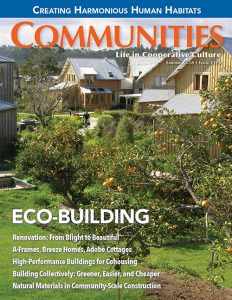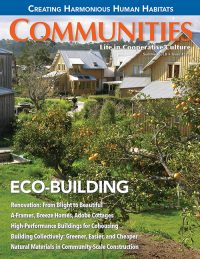 The Summer 2018 edition of Communities, focused on “Eco-Building,” is now available by donation for digital download.
The Summer 2018 edition of Communities, focused on “Eco-Building,” is now available by donation for digital download.
For reasons both practical and ideological, intentional community has long been a hotbed of eco-building activity—optimizing available resources while enriching participants’ relationships to self, others, and nature. In Communities’ “Eco-Building” issue (Summer 2018, #179), authors share their eco-building journeys, ranging from nearly-free stick-framed shelters to high-end green developments. They examine how to assess whether a building is actually “eco,” hard choices they’ve needed to make, the benefits and challenges of taking on eco-building projects in community, or of retrofitting vs. building new, and much more. We hope you’ll draw useful information, inspiration, and insight from their stories. Once again, the issue is available via free/by donation digital download at ic.org/communities.
You can download the digital version or order the print version here.
Eco-Building: Issue #179 ● Summer 2018
Theme Articles
Adventures of the Mini Moon: Realities of building your own earthen house with reused materials and volunteer labor By Jenny Leis
Becoming a general contractor for a project way beyond one’s abilities can be a powerful, humbling, community-building learning adventure, especially when the house is made of horse manure.
● What I Learned about Local, Natural, Reused Materials
● My Budget
Building Collectively Is Greener, Easier, and Cheaper By Jenny Pickerill
Eco-building in community offers both opportunities and challenges, benefits and potential drawbacks, as compared to doing it alone.
Harmonious Homemade Habitat By Laura Harris
Having built the strawbale house of her dreams, a Tolstoy Farm resident encourages others to use natural building and eco-materials to construct durable, nontoxic, low-impact, energy-efficient, and creative structures.
Building in an Ecovillage: Lessons Learned By Tony “Papa Bear” Barrett
Yes, you can build your own house; you don’t have to do it alone; you don’t have to do it all…and 18 more tips from a professional builder who learned his trade at Dancing Rabbit Ecovillage.
Ionia’s Barn Project: Where Community and Natural Building Meet By Eliza Eller
At this cooperative ecovillage, the barn is magical, a space that will make a liberating special meeting area, meditation nook, reading loft, and more…once, after nine long years of building, it is done.
Building with Respect By Alexis Zeigler
Green building could be our salvation or hasten our destruction, depending on what we pursue and how. Here are a dozen suggestions to make the former more likely.
Eco-Building at the Ecovillage (I Have Built a Home) By Arjuna da Silva
At Earthaven Ecovillage, the experience of planning, building, working with others, and living in the sensual, earthy “Leela”—part temple, part hideaway—proves to be a dream come true.
Good Neighbours with Earth: Using natural building materials in community-scale construction By Robin Allison
Earthsong Eco-Neighbourhood offers their mistakes, successes, and learnings in the hope of encouraging the wider use of natural building materials and systems in cohousing projects.
A High-Performance Building for Cohousing: From Vision to Move-In By Michael Mariano
So you want to design, build, and live in community in the most ecologically positive building that can be built? After a decade-long pursuit of that goal, a co-creator of Capitol Hill Urban Cohousing recounts lessons learned along the way.
From Blight to Beautiful: Renovating an Urban House By and For Community By Lindsay Speer
An overgrown lot with a dilapidated house transforms into an urban permaculture oasis thanks to the efforts of the Bread and Roses Collective in Syracuse, New York.
A Life Recycled By Helen Iles
A Welsh filmmaker and her husband retrofit a tumble-down shack in the Spanish forest, picking up skills and discovering that it might have been much easier to build from scratch.
A Family Builds its Breeze Home in Paradise By Stefano Quarta
At GaiaYoga Gardens, a young family finds its shifting needs met when it gets permission to build its own new, wall-less living structure, completed just in time for the baby.
An Ax, a Rope, and Teamwork: Build a Simple A-Frame Shelter for Under $100 By Murphy Robinson
If you and four friends each chip in $20 and two days of work, you can have a hearth for your community that connects you to the land as well.
The Concrete Thinking of Hobbits By Dan Schultz
What makes Maitreya Mountain Village’s multi-functional Hobbit Hole so eco-friendly is that it’s constructed of concrete. Yes, you read that right.
● Pros and Cons of Concrete
Rebuilding Remote Island Communities, One Adobe Cottage at a Time By Philip Mirkin
The Fiji Institute of Sustainable Habitats assists local recovery from Tropical Cyclone Winston with rounded, cyclone-resistant structures made from local, natural materials.
Eco-Design for Behavior Change By Cheryl Gladu
Design for environmental and social sustainability should never simply be about applying new technologies onto our existing models of living.
Learning to Say “ECO-BUILD” in Your Own Vernacular—Or, What Is Eco-Building, and How Do You Know You’re Doing It Right? By Oliver Ogden
An eco-builder shares his own growth, offers insights into how to work through a homemaking journey, and shares a basic tenet: eco-building is different depending on location.
Eco-Energy at Heartwood Cohousing By Richard Grossman and the Common Facilities Team of Heartwood Cohousing
Even if a person or community cannot afford the infrastructure to provide renewable energy at the time of building, they can build in such a way that it is easy to add later.
● Creating Budgetary Line Items for Ecological Upgrades—Maraiah Lynn Nadeau
Voices
Letters
Notes from the Editor Building for the Future By Chris Roth
Review Remembering Zendik: Mating in Captivity By Chris Roth
Helen Zuman’s debut book describes in detail her six-year-long involvement with a radical intentional community that also fits many people’s definition of “cult.”
Excerpted from the Summer 2018 edition of Communities, “Eco-Building”—full issue available for download (by voluntary donation) here.












